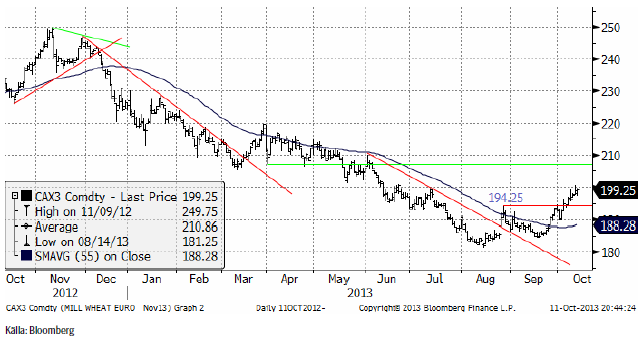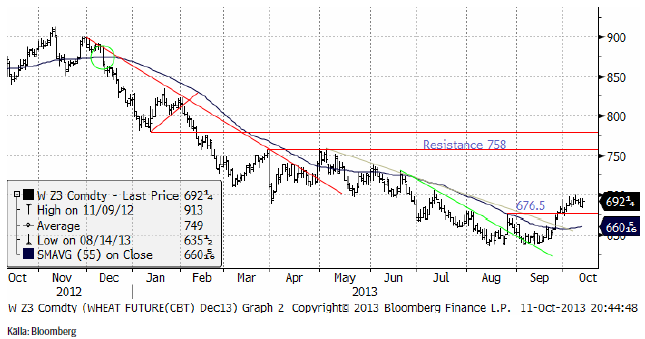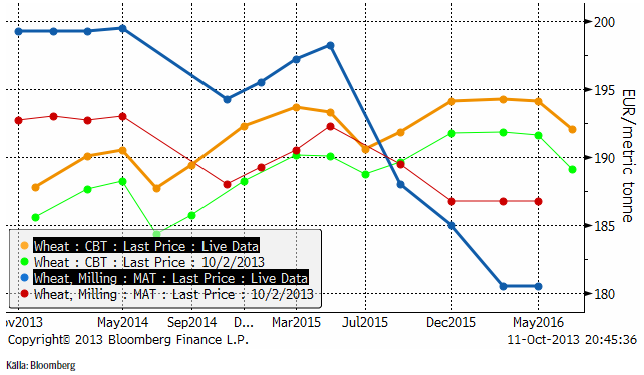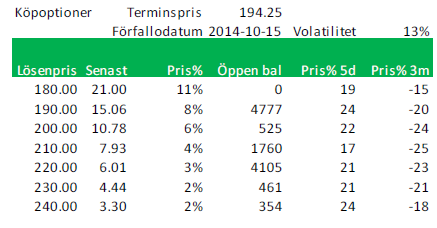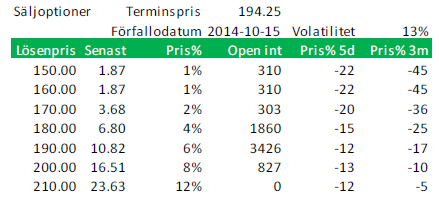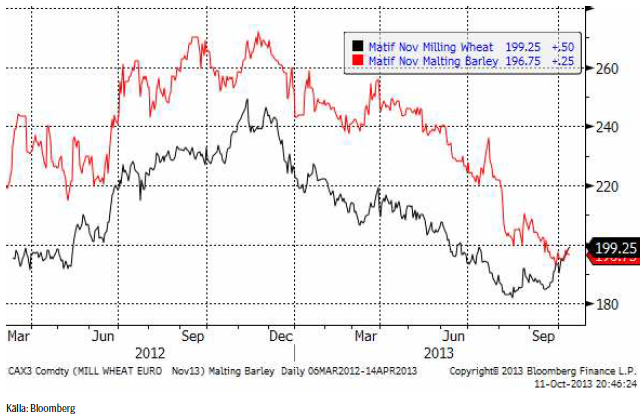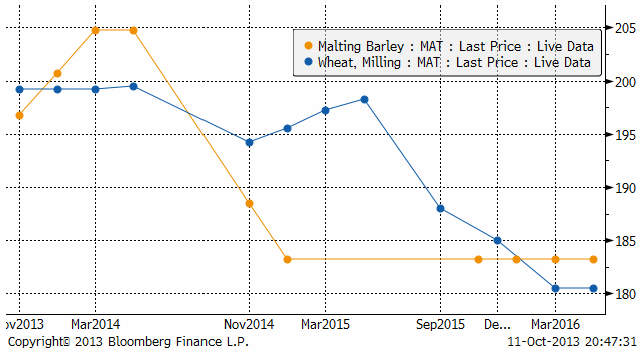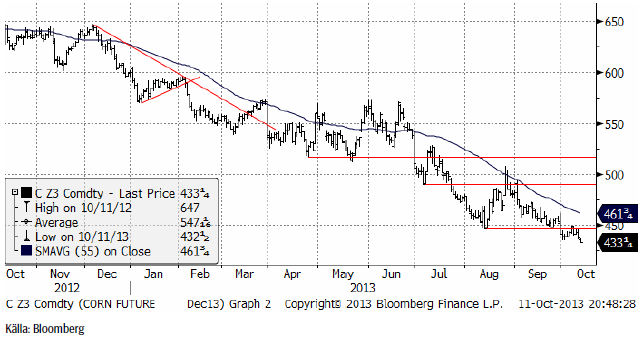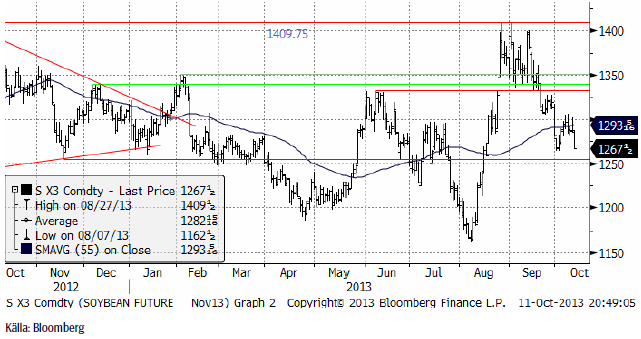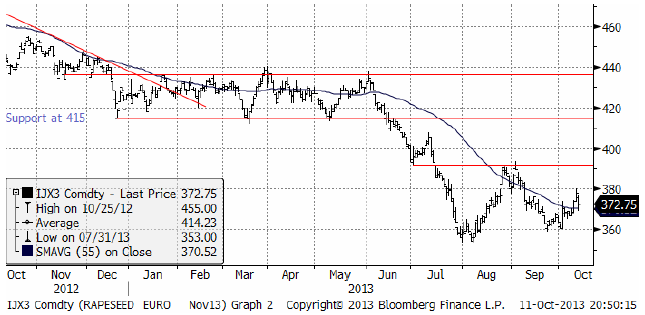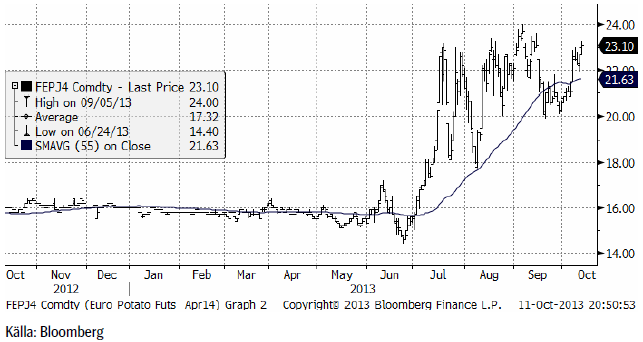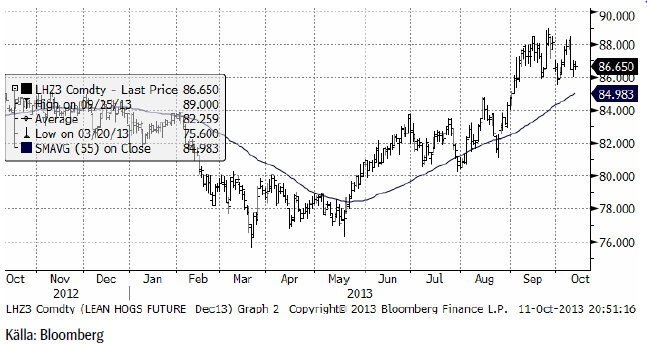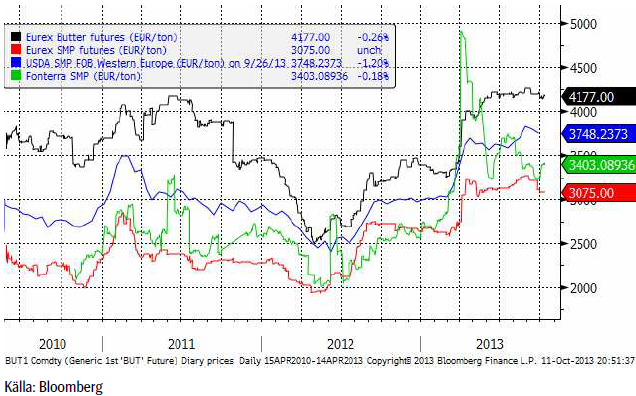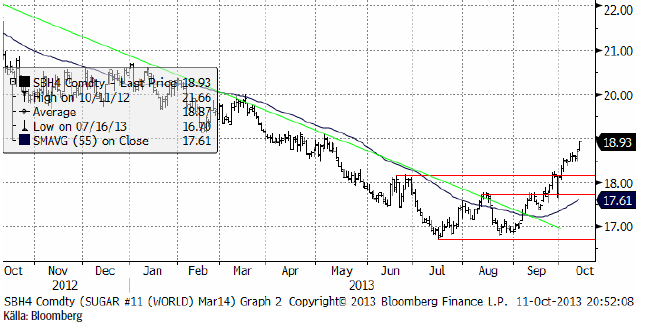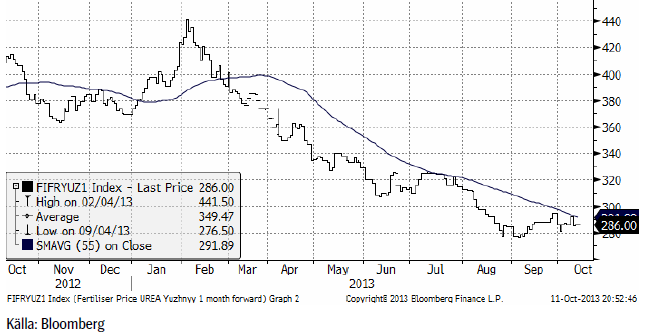Analys
SEB Jordbruksprodukter, 14 oktober 2013
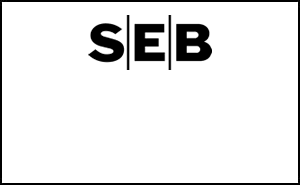
 Vete, raps, potatis och socker gick upp förra veckan, majs och sojabönor ner. Det var en lugn vecka förra veckan, främst på grund av European Exchange, som gick av stapeln i Paris under torsdagen och fredagen. Med nästan hela den Europeiska marknaden i Paris blev handeln tunn.
Vete, raps, potatis och socker gick upp förra veckan, majs och sojabönor ner. Det var en lugn vecka förra veckan, främst på grund av European Exchange, som gick av stapeln i Paris under torsdagen och fredagen. Med nästan hela den Europeiska marknaden i Paris blev handeln tunn.
Vete
November månads terminskontrakt på Matif har gått upp mot 200 euro, ett tekniskt motstånd. Det har varit en god uppgång och många kommer att vilja sälja till 200 euro. Vi gissar en det kommer en rekyl nedåt den här veckan, vilket vi tror är ett köptillfälle.
Decemberkontraktet på CBOT har haft svårt att ta sig över 700 cent, på samma sätt som Matif kämpar med 200 euro.
Nedan ser vi terminskurvorna för Chicagovete och Matif. Det är nästan backwardation i Matifmarknaden. Det är en återspegling av att så många lantbrukare håller på sitt vete för att de tror att priset ska stiga. Istället borde de sälja sin spannmål och ta sin position genom att köpa terminer. Det bytet innebär samma position i marknaden, samma antal ton, men pengar på banken (räntevinst), ingen risk för försämring av varan i lager och möjligheten att köpa på termin utan terminspåslag.
GASC ratade erbjudandena i veckan därför att man tyckte att priset var för högt.
Argentinas BAGE estimerade den kommande Argentinska veteskörden till drygt 10 mt. USDA:s senaste WASDE i september angav den till 12 mt.
 USA:s jordbruksdepartement är stängt pga budgetproblemen, vilket innebär att vi inte har några crop conditions, inga exportsiffror och ingen WASDE-rapport. Den skulle ha kommit den 11 september och analytikerna behöver ca 10 dagar på sig. Det innebär att den kan komma först den 24 oktober. Då är det nästan ingen idé att publicera den, vilket kan innebära att den helt kommer att utgå.
USA:s jordbruksdepartement är stängt pga budgetproblemen, vilket innebär att vi inte har några crop conditions, inga exportsiffror och ingen WASDE-rapport. Den skulle ha kommit den 11 september och analytikerna behöver ca 10 dagar på sig. Det innebär att den kan komma först den 24 oktober. Då är det nästan ingen idé att publicera den, vilket kan innebära att den helt kommer att utgå.
Även Europa var lugnt mot slutet av veckan på grund av European Exchange i Paris i torsdags och fredags. European Exchange är en mötesplats för alla i den europeiska spannmålsbranschen.
Den långsamma sådden i Ukraina är en faktor som påverkat prisutvecklingen positivt. Nu har vädret blivit bättre, vilket gör att höstarbetet underlättas.
Vi får en del frågor om optioner. Den som vill köpa en option via SEB kan göra det. Det behövs ett ramavtal, men däremot behöver banken inte göra en kreditprövning och man behöver inte heller ställa säkerhet, eftersom man som kund betalar priset (”premien”) i början och sedan erhåller eventuellt realvärde vid optionens lösen. Man behöver inte heller påkalla lösen själv, utan det sköts automatiskt till kontot i banken.
Det är så kort tid kvar till förfallet för novemberterminen 2013, så nedan ser vi priserna på köpoptioner på Matif på November-2014 (Matif vete). Notera att volatiliteten 13% är ganska låg. Volatiliteten brukar vara låg när priserna är låga.
Nedanstående optioner är köpoptioner. Terminen (Nov 2014) handlas i 194.25 euro per ton. En köpoption om ett ton vete, som ger rätt att köpa vete för 200 euro kostar 10.78 euro, eller 6% av 194.25 euro. När man köper optionen får man betala det beloppet (plus lite till för säljkurs, detta är senast betalt). Om priset i oktober (vid förfall) nästa år är 250 euro på terminen betalar banken 50 euro till optionsinnehavaren (omräknat till kronor om man vill och kommer överens om det). Om terminen står i 190 euro (under lösenpriset) förfaller optionen värdelös och inget belopp betalas ut.
Nedanstående är priser på säljoptioner. Om du köpt optionen med lösenpris 200 euro (för 16.51) och terminen i oktober nästa år står i 180 euro, betalar banken ut 20 euro. Om terminspriset är över 200 euro betalar banken inte ut någonting alls och optionen förfaller värdelös.
En del använder optioner för att spekulera kortsiktigt. Som du ser av kolumnen Pris% 5d, som visar den procentuella prisförändringen på respektive option, rör sig priser på optioner med en väsentlig utväxling i förhållande till förändringar i terminspriset.
Vi har alltså köprekommendation på vete, men tror att en rekyl nedåt kan komma. Vi betraktar en sådan rekyl nedåt som ett köptillfälle.
Maltkorn
Terminspriset (november) ligger återigen under Matif:s kvarnvetekontrakt för november.
Som vi ser av diagrammet nedan, ligger novembers maltkornskontrakt under vetet, men januari, mars och maj ligger alla över. Det indikerar ett ”överutbud” av maltkorn just nu och / eller en brist på kvarnvete.
Majs
Majspriset (december 2013) har fortsatt att falla. Nyhetsflödet har gett bränsle åt nedgången: Dels har siffrorna på väntad skörd per acre i USA fortsatt att förbättras, dels har brasilianska CONAB estimerat landets skörd 2014 till 78 – 80 mt i veckan. Det ska jämföras med USDA:s senaste estimat på 72 mt. Tidigare rapporter indikerade också lägre sådd av majs och motsvarande mer av sojabönor. Även på efterfrågesidan har negativ information kommit. Amerikanska EPA väntas sänka inblandningsmandatet av etanol i bensin med 1.4 miljarder gallons, vilket leder till en minskad efterfrågan på majs med upp till 500 miljoner bushels. Efterfrågan till etanol har inte ökat alls de senaste åren, efter att man kommit upp i 10% (”blending wall”) etanol.
Det är oroväckande att majsen handlats så svagt, men vi tror ändå att priserna är nära botten och att förhållandet mellan sojabönor (oljeväxter) och majs (spannmål) leder till mindre produktion av majs – med högre pris i framtiden som konsekvens.
Vi väljer att hålla fast vid köprekommendationen.
Sojabönor
Novemberkontraktet på sojabönor slutade förra veckan med ett rejält prisfall. Priset närmar sig den nivå på 1250 som vi talade om för några veckor sedan. Bakom fredagens prisfall låg samma faktor som bakom prisfallet i majsmarknaden – en oro för att EPA ska komma att sänka inblandningskravet avseende biobränslen, i fallet för sojabönor gällde det biodiesel.
Brasilianska CONAB estimerar landets skörd 2014 till 87.6 – 89.7 mt. Det är något högre än USDA:s 88 mt.
I USA talar en del nu, något oväntat, om en skörd på 43 bushels per acre. Efter torkan i augusti har marknaden tagit emot en serie av estimat från privata firmor och analytiker som visar på bättre skörd än befarat.
Vi behåller säljrekommendation.
Raps
Rapspriset (november 2013) fortsatte att stiga i början av förra veckan efter beskedet om att en strafftull kommer att införas mot 90% av EU:s import av biodiesel. Den här frågan var ”snackisen” på European Exchange som gick av stapeln i Paris i torsdags och fredags. Samtalet rörde främst ”vem” som fått kännedom om beslutet innan det offentliggjordes.
Vi behåller säljrekommendationen på raps.
Potatis
Potatispriset av årets skörd, som handlas i april-kontraktet på Eurex, har vänt upp till den högsta nivån på en månad, en uppgång från början av oktober med 15%, till 23.10 euro per dt. 24 euro ser ut att vara inom räckhåll.
Gris
Prist på Lean Hogs fortsatta att röra sig ”sidledes” inom vad vi tolkar som en ”toppformation”, baserat på kända mönster inom den tekniska analys-skolan.
Mjölk
Terminerna på smör och skummjölkspulver vid Eurex-börsen var stabila och rörde sig inte mycket under veckan som gick. Fonterras pris steg något, efter det kraftiga prisfall från toppen som varit.
Socker
Marskontraktet på råsocker steg kraftigt upp till 18.93 cent på marskontraktet. Vid 19 cent finns ett starkt motstånd och det skulle inte förvåna om vinsthemtagningar sätter in, som kan ta ner priset till 18 cent. Vi tror att det, om det händer, är ett utmärkt köptillfälle.
Gödsel
Priset på kväve / urea var stabilt i veckan som gick med endast små kursförändringar.
[box]SEB Veckobrev Jordbruksprodukter är producerat av SEB Commodities Sales desk och publiceras i samarbete och med tillstånd på Råvarumarknaden.se[/box]
Detta marknadsföringsmaterial, framtaget av SEB’s Commodities Sales desk, har upprättats enbart i informationssyfte.
Även om innehållet är baserat på källor som SEB bedömt som tillförlitliga ansvarar SEB inte för fel eller brister i informationen. Den utgör inte oberoende, objektiv investeringsanalys och skyddas därför inte av de bestämmelser som SEB har infört för att förebygga potentiella intressekonflikter. Yttranden från SEB’s Commodities Sales desk kan vara oförenliga med tidigare publicerat material från SEB, då den senare hänvisas uppmanas du att läsa den fullständiga rapporten innan någon åtgärd vidtas.
Dokumentationen utgör inte någon investeringsrådgivning och tillhandahålls till dig utan hänsyn till dina investeringsmål. Du uppmanas att självständigt bedöma och komplettera uppgifterna i denna dokumentation och att basera dina investeringsbeslut på material som bedöms erforderligt. Alla framåtblickande uttalanden, åsikter och förväntningar är föremål för risker, osäkerheter och andra faktorer och kan orsaka att det faktiska resultatet avviker väsentligt från det förväntade. Historisk avkastning är ingen garanti för framtida resultat. Detta dokument utgör inte ett erbjudande att teckna några värdepapper eller andra finansiella instrument. SEB svarar inte för förlust eller skada – direkt eller indirekt, eller av vad slag det vara må – som kan uppkomma till följd av användandet av detta material eller dess innehåll.
Observera att det kan förekomma att SEB, dess ledamöter, dess anställda eller dess moder- och/eller dotterbolag vid olika tillfällen innehar, har innehaft eller kommer att inneha aktier, positioner, rådgivningsuppdrag i samband med corporate finance-transaktioner, investment- eller merchantbankinguppdrag och/eller lån i de bolag/finansiella instrument som nämns i materialet.
Materialet är avsett för mottagaren, all spridning, distribuering mångfaldigande eller annan användning av detta meddelande får inte ske utan SEB:s medgivande. Oaktat detta får SEB tillåta omfördelning av materialet till utvald tredje part i enlighet med gällande avtal. Materialet får inte spridas till fysiska eller juridiska personer som är medborgare eller har hemvist i ett land där sådan spridning är otillåten enligt tillämplig lag eller annan bestämmelse.
Skandinaviska Enskilda Banken AB (publ) är ett [publikt] aktiebolag och står under tillsyn av Finansinspektionen samt de lokala finansiella tillsynsmyndigheter i varje jurisdiktionen där SEB har filial eller dotterbolag.
Analys
More weakness and lower price levels ahead, but the world won’t drown in oil in 2026

Some rebound but not much. Brent crude rebounded 1.5% yesterday to $65.47/b. This morning it is inching 0.2% up to $65.6/b. The lowest close last week was on Thursday at $64.11/b.

The curve structure is almost as week as it was before the weekend. The rebound we now have gotten post the message from OPEC+ over the weekend is to a large degree a rebound along the curve rather than much strengthening at the front-end of the curve. That part of the curve structure is almost as weak as it was last Thursday.
We are still on a weakening path. The message from OPEC+ over the weekend was we are still on a weakening path with rising supply from the group. It is just not as rapidly weakening as was feared ahead of the weekend when a quota hike of 500 kb/d/mth for November was discussed.
The Brent curve is on its way to full contango with Brent dipping into the $50ies/b. Thus the ongoing weakening we have had in the crude curve since the start of the year, and especially since early June, will continue until the Brent crude oil forward curve is in full contango along with visibly rising US and OECD oil inventories. The front-month Brent contract will then flip down towards the $60/b-line and below into the $50ies/b.
At what point will OPEC+ turn to cuts? The big question then becomes: When will OPEC+ turn around to make some cuts? At what (price) point will they choose to stabilize the market? Because for sure they will. Higher oil inventories, some more shedding of drilling rigs in US shale and Brent into the 50ies somewhere is probably where the group will step in.
There is nothing we have seen from the group so far which indicates that they will close their eyes, let the world drown in oil and the oil price crash to $40/b or below.
The message from OPEC+ is also about balance and stability. The world won’t drown in oil in 2026. The message from the group as far as we manage to interpret it is twofold: 1) Taking back market share which requires a lower price for non-OPEC+ to back off a bit, and 2) Oil market stability and balance. It is not just about 1. Thus fretting about how we are all going to drown in oil in 2026 is totally off the mark by just focusing on point 1.
When to buy cal 2026? Before Christmas when Brent hits $55/b and before OPEC+ holds its last meeting of the year which is likely to be in early December.
Brent crude oil prices have rebounded a bit along the forward curve. Not much strengthening in the structure of the curve. The front-end backwardation is not much stronger today than on its weakest level so far this year which was on Thursday last week.

The front-end backwardation fell to its weakest level so far this year on Thursday last week. A slight pickup yesterday and today, but still very close to the weakest year to date. More oil from OPEC+ in the coming months and softer demand and rising inventories. We are heading for yet softer levels.

Analys
A sharp weakening at the core of the oil market: The Dubai curve

Down to the lowest since early May. Brent crude has fallen sharply the latest four days. It closed at USD 64.11/b yesterday which is the lowest since early May. It is staging a 1.3% rebound this morning along with gains in both equities and industrial metals with an added touch of support from a softer USD on top.

What stands out the most to us this week is the collapse in the Dubai one to three months time-spread.
Dubai is medium sour crude. OPEC+ is in general medium sour crude production. Asian refineries are predominantly designed to process medium sour crude. So Dubai is the real measure of the balance between OPEC+ holding back or not versus Asian oil demand for consumption and stock building.
A sharp weakening of the front-end of the Dubai curve. The front-end of the Dubai crude curve has been holding out very solidly throughout this summer while the front-end of the Brent and WTI curves have been steadily softening. But the strength in the Dubai curve in our view was carrying the crude oil market in general. A source of strength in the crude oil market. The core of the strength.
The now finally sharp decline of the front-end of the Dubai crude curve is thus a strong shift. Weakness in the Dubai crude marker is weakness in the core of the oil market. The core which has helped to hold the oil market elevated.
Facts supports the weakening. Add in facts of Iraq lifting production from Kurdistan through Turkey. Saudi Arabia lifting production to 10 mb/d in September (normal production level) and lifting exports as well as domestic demand for oil for power for air con is fading along with summer heat. Add also in counter seasonal rise in US crude and product stocks last week. US oil stocks usually decline by 1.3 mb/week this time of year. Last week they instead rose 6.4 mb/week (+7.2 mb if including SPR). Total US commercial oil stocks are now only 2.1 mb below the 2015-19 seasonal average. US oil stocks normally decline from now to Christmas. If they instead continue to rise, then it will be strongly counter seasonal rise and will create a very strong bearish pressure on oil prices.
Will OPEC+ lift its voluntary quotas by zero, 137 kb/d, 500 kb/d or 1.5 mb/d? On Sunday of course OPEC+ will decide on how much to unwind of the remaining 1.5 mb/d of voluntary quotas for November. Will it be 137 kb/d yet again as for October? Will it be 500 kb/d as was talked about earlier this week? Or will it be a full unwind in one go of 1.5 mb/d? We think most likely now it will be at least 500 kb/d and possibly a full unwind. We discussed this in a not earlier this week: ”500 kb/d of voluntary quotas in October. But a full unwind of 1.5 mb/d”
The strength in the front-end of the Dubai curve held out through summer while Brent and WTI curve structures weakened steadily. That core strength helped to keep flat crude oil prices elevated close to the 70-line. Now also the Dubai curve has given in.

Brent crude oil forward curves

Total US commercial stocks now close to normal. Counter seasonal rise last week. Rest of year?

Total US crude and product stocks on a steady trend higher.

Analys
OPEC+ will likely unwind 500 kb/d of voluntary quotas in October. But a full unwind of 1.5 mb/d in one go could be in the cards

Down to mid-60ies as Iraq lifts production while Saudi may be tired of voluntary cut frugality. The Brent December contract dropped 1.6% yesterday to USD 66.03/b. This morning it is down another 0.3% to USD 65.8/b. The drop in the price came on the back of the combined news that Iraq has resumed 190 kb/d of production in Kurdistan with exports through Turkey while OPEC+ delegates send signals that the group will unwind the remaining 1.65 mb/d (less the 137 kb/d in October) of voluntary cuts at a pace of 500 kb/d per month pace.

Signals of accelerated unwind and Iraqi increase may be connected. Russia, Kazakhstan and Iraq were main offenders versus the voluntary quotas they had agreed to follow. Russia had a production ’debt’ (cumulative overproduction versus quota) of close to 90 mb in March this year while Kazakhstan had a ’debt’ of about 60 mb and the same for Iraq. This apparently made Saudi Arabia angry this spring. Why should Saudi Arabia hold back if the other voluntary cutters were just freeriding? Thus the sudden rapid unwinding of voluntary cuts. That is at least one angle of explanations for the accelerated unwinding.
If the offenders with production debts then refrained from lifting production as the voluntary cuts were rapidly unwinded, then they could ’pay back’ their ’debts’ as they would under-produce versus the new and steadily higher quotas.
Forget about Kazakhstan. Its production was just too far above the quotas with no hope that the country would hold back production due to cross-ownership of oil assets by international oil companies. But Russia and Iraq should be able to do it.
Iraqi cumulative overproduction versus quotas could reach 85-90 mb in October. Iraq has however steadily continued to overproduce by 3-5 mb per month. In July its new and gradually higher quota came close to equal with a cumulative overproduction of only 0.6 mb that month. In August again however its production had an overshoot of 100 kb/d or 3.1 mb for the month. Its cumulative production debt had then risen to close to 80 mb. We don’t know for September yet. But looking at October we now know that its production will likely average close to 4.5 mb/d due to the revival of 190 kb/d of production in Kurdistan. Its quota however will only be 4.24 mb/d. Its overproduction in October will thus likely be around 250 kb/d above its quota with its production debt rising another 7-8 mb to a total of close to 90 mb.
Again, why should Saudi Arabia be frugal while Iraq is freeriding. Better to get rid of the voluntary quotas as quickly as possible and then start all over with clean sheets.
Unwinding the remaining 1.513 mb/d in one go in October? If OPEC+ unwinds the remaining 1.513 mb/d of voluntary cuts in one big go in October, then Iraq’s quota will be around 4.4 mb/d for October versus its likely production of close to 4.5 mb/d for the coming month..
OPEC+ should thus unwind the remaining 1.513 mb/d (1.65 – 0.137 mb/d) in one go for October in order for the quota of Iraq to be able to keep track with Iraq’s actual production increase.
October 5 will show how it plays out. But a quota unwind of at least 500 kb/d for Oct seems likely. An overall increase of at least 500 kb/d in the voluntary quota for October looks likely. But it could be the whole 1.513 mb/d in one go. If the increase in the quota is ’only’ 500 kb/d then Iraqi cumulative production will still rise by 5.7 mb to a total of 85 mb in October.
Iraqi production debt versus quotas will likely rise by 5.7 mb in October if OPEC+ only lifts the overall quota by 500 kb/d in October. Here assuming historical production debt did not rise in September. That Iraq lifts its production by 190 kb/d in October to 4.47 mb/d (August level + 190 kb/d) and that OPEC+ unwinds 500 kb/d of the remining quotas in October when they decide on this on 5 October.

-

 Nyheter4 veckor sedan
Nyheter4 veckor sedanMahvie Minerals i en guldtrend
-

 Analys4 veckor sedan
Analys4 veckor sedanVolatile but going nowhere. Brent crude circles USD 66 as market weighs surplus vs risk
-

 Nyheter4 veckor sedan
Nyheter4 veckor sedanAktier i guldbolag laggar priset på guld
-

 Nyheter4 veckor sedan
Nyheter4 veckor sedanKinas elproduktion slog nytt rekord i augusti, vilket även kolkraft gjorde
-

 Nyheter3 veckor sedan
Nyheter3 veckor sedanTyskland har så höga elpriser att företag inte har råd att använda elektricitet
-

 Nyheter4 veckor sedan
Nyheter4 veckor sedanGuld når sin högsta nivå någonsin, nu även justerat för inflation
-

 Nyheter4 veckor sedan
Nyheter4 veckor sedanDet stigande guldpriset en utmaning för smyckesköpare
-

 Analys4 veckor sedan
Analys4 veckor sedanWaiting for the surplus while we worry about Israel and Qatar


